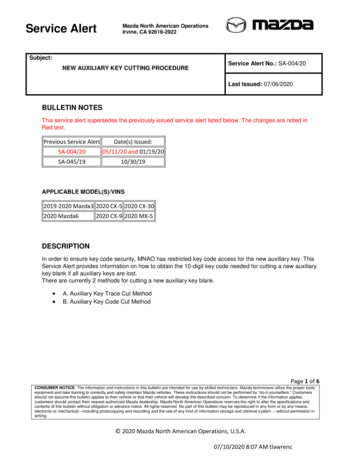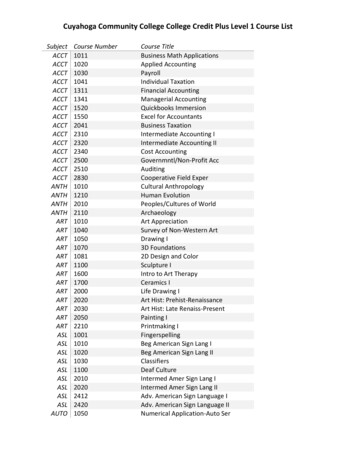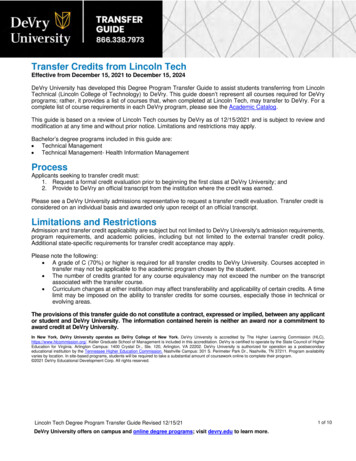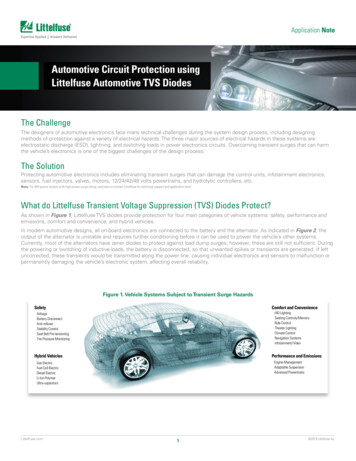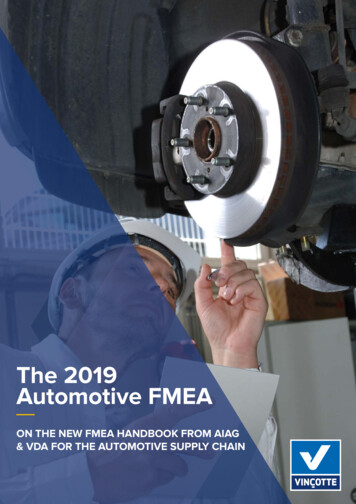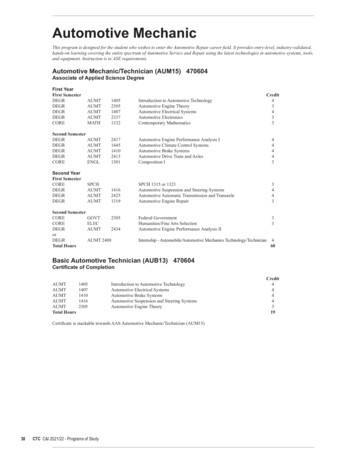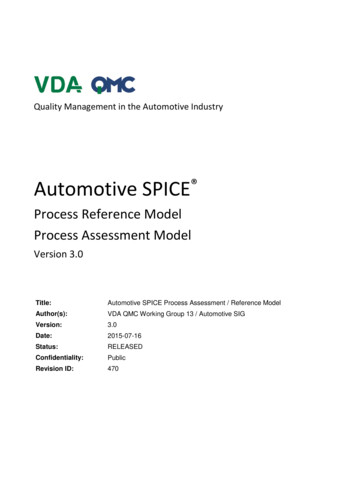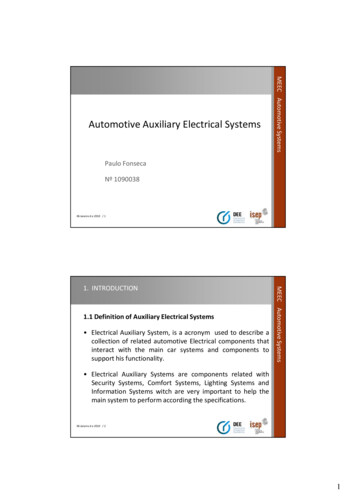
Transcription
MEEC Automotive SystemsAutomotive Auxiliary Electrical SystemsPaulo FonsecaNº 109003806 Janeiro d e 2010 / 11.1 Definition of Auxiliary Electrical Systems Electrical Auxiliary System, is a acronym used to describe acollection of related automotive Electrical components thatinteract with the main car systems and components tosupport his functionality.MEEC Automotive Systems1. INTRODUCTION Electrical Auxiliary Systems are components related withSecurity Systems, Comfort Systems, Lighting Systems andInformation Systems witch are very important to help themain system to perform according the specifications.06 Janeiro d e 2010 / 21
1.2 Taxonomy of Auxiliary Electrical Systems.Auxiliary Electrical SystemsComfort andSafety SystemsSecurity Systems Central lockingdoor system Locking door withdistance command. Biometric system. Anti steel system.Lighting Systems Seat adjustment. Front Lighting. Windows control. Rear lighting.Information Systems Instruments panel.MEEC Automotive Systems1. INTRODUCTION Trip recorder. Sun roof control. Compartment lighting. Windshield wiperand window cleaning. Compartment HVAC. Control view mirrors Signalization lighting. Board computer. Multimedia.06 Janeiro d e 2010 / 31.2 Taxonomy of Auxiliary Electrical Systems. (cont) Conclusion.MEEC Automotive Systems1. INTRODUCTION06 Janeiro d e 2010 / 42
2.1 Security systems - Central locking door system Either pneumatic or electric actuators can be used to power centrallocking systems Used for vehicle doors, luggage compartments and fuel-filler flaps.MEEC Automotive Systems2. ELECTRICAL AUXILIARY SYSTEMS There are two types of locking systems :– Electrical /Pneumatic.– Electrical only actuation.06 Janeiro d e 2010 / 52.1Security systems - Central locking door system (cont) In pneumatic systems, an electric motor drives the reversible dualpressure pump. The pump provides the required system pressure (positive or vacuum). The system can be switched on and off by a central position switchinside the vehicle and by the ignition switch. MEEC Automotive Systems2. ELECTRICAL AUXILIARY SYSTEMSAs an optional feature, the system can be operated from a number ofpoints (driver door, front-seat passenger door, and trunk lid). More widespread than the pneumatic systems are those which dependonly from Electrical actuation.06 Janeiro d e 2010 / 63
2.1Security systems - Central locking door system (cont) Electric motors for central locking, although various technologies areused, according to function range and lock type, the basic principleremains constant: a small electric motor. The electric motor reduction-gear drive unit powers the actuating levelresponsible for opening and closing the lock.MEEC Automotive Systems2. ELECTRICAL AUXILIARY SYSTEMS Provision must be made to ensure that the door can always be unlockedwith the key and the interior handle in the event of a power failure. Central locking systems incorporating special theft-deterrence featuresmust be designed to preclude deactivation of the security system usingany means other than the vehicle key.06 Janeiro d e 2010 / 72.1 Security systems – Central locking door system (cont)The Figure shows the block diagram for a general locking system.MEEC Automotive Systems2. ELECTRICAL AUXILIARY SYSTEMS06 Janeiro d e 2010 / 84
2.1 Security systems - Central door locking system (cont)Initial system statusSystem LockedMEEC Automotive Systems2. ELECTRICAL AUXILIARY SYSTEMSUnlocking the system06 Janeiro d e 2010 / 92.1 Security systems - Central door locking system (cont)The figure shows a Electric locking system as explain.MEEC Automotive Systems2. ELECTRICAL AUXILIARY SYSTEMS06 Janeiro d e 2010 / 105
2.1 Security systems - Locking door with distance command The system is a variant of the Central door locking as it was seen onprevious topic. The innovation is the possibility to integrate a remote hand command byinfra red or by RF to give order for open/close the doors.MEEC Automotive Systems2. ELECTRICAL AUXILIARY SYSTEMS This system has a receiver unit installed on the vehicle that receives thecommand from the hand transmitter. If the code in memory is the same as the received one then a signal thatis connected in parallel with gear motors will actuate them andopen/close the doors.06 Janeiro d e 2010 / 112.1 Security systems - Locking door with distance command (cont). The code can be modified and has about 59048 combinations (depends from thetype of remote command). Generally the receivers can have a setup to receive more than one code, thishappens when the vehicle will have several drivers. Each one has a handcommand with a different code that will be recognized by the receiver unit.MEEC Automotive Systems2. ELECTRICAL AUXILIARY SYSTEMS Nowadays, the car is equipped with anti steal system, the hand remotecommand can also activate the anti steal system by pressing two times theswitch. In this case a red led start blinking , this confirms that the anti stealsystem is activated.06 Janeiro d e 2010 / 126
2.1 Security systems – Biometric system. The figures shows examples of applications of biometric sensors.MEEC Automotive Systems2. ELECTRICAL AUXILIARY SYSTEMS06 Janeiro d e 2010 / 132.1 Security systems – Biometric system (cont) Biometric system recognition has the main function to check andconfirm the identity of the peoples based on biometric characteristics. At moment there are Known about ten biometric processes, betweenthem the most relevant are the following ones:– Identification of finger print.MEEC Automotive Systems2. ELECTRICAL AUXILIARY SYSTEMS– Identification of face lines.– Identification of Iris.– Identification of voice.06 Janeiro d e 2010 / 147
2.1 Security systems – Biometric system. (cont) For automotive vehicles it is used more frequently de finger print witchgives a more comprehensive differentiation of the identities. This technology gives more security compared with the car Key, that forinstance could be lost. Note that de biometric characteristics are carriedby the person. Also, the technology gives information about the identity of the personthat drives the car.MEEC Automotive Systems2. ELECTRICAL AUXILIARY SYSTEMS To Identify a finger print, first is necessary to register it. This is done bydata acquisition of the finger print using a sensor with gray scale colorand size ( 64000 to 96000 pixel with resolution of 8 bit/pixel).06 Janeiro d e 2010 / 152.1 Security systems – Biometric system. (cont) Digital finger print sensor based on direct opticalscanning (DiOS).a.Image sensor CMOS with finger.b.Detail of information.1- Light.MEEC Automotive Systems2. ELECTRICAL AUXILIARY SYSTEMS2- scene Finger lines.3- Led Light from bottom.4- optical fiber beam.5- Sensitive sensor .06 Janeiro d e 2010 / 168
2.1 Security systems – Biometric system (cont) The Access to the car, the sensors to identify the finger print needs to beinstalled on the doors outside. The main technologic challenge is to increase the mechanic hardnessand protection of the sensor.MEEC Automotive Systems2. ELECTRICAL AUXILIARY SYSTEMS The Sensor should be protected against bad weather conditions andcrashes.06 Janeiro d e 2010 / 172.1 Security systems- Anti Steal system Car and alarm manufacturers are constantly fighting to improvesecurity. Building the alarm system as an integral part of the vehicleelectronics has made significant improvements. Even so, retrofitsystems can still be very effective. Three main types of intruder alarm are used:MEEC Automotive Systems2. ELECTRICAL AUXILIARY SYSTEMS– Switch operated on all entry points.– Battery voltage sensed.– Volumetric sensing.06 Janeiro d e 2010 / 189
2.1 Security systems - Anti Steal system (cont) There are three main ways to disable the vehicle.– Ignition circuit cut off.– Starter circuit cut off.MEEC Automotive Systems2. ELECTRICAL AUXILIARY SYSTEMS– Engine ECU (Electronic control unit ) code lock. A separate switch or IR transmitter can be used to set an alarm system.Often, they are set automatically when the doors are locked.06 Janeiro d e 2010 / 192.1 Security systems - Anti Steal system (cont) The following is an overview of the good alarm systems now availableeither as a retro-fit or factory fitted. Most are made for 12V. They have electronic sirens and give an audible signal when arming anddisarming. They are all triggered when the car door opens and will automaticallyreset after a period of time, often 1 or 2 minutes.MEEC Automotive Systems2. ELECTRICAL AUXILIARY SYSTEMS The alarms are triggered instantly when an entry point is breached. Most systems can be considered as two pieces, with a separate controlunit and siren.06 Janeiro d e 2010 / 2010
2.1 Security systems - Anti Steal system (cont) Most systems have the control unit in the passenger compartment andthe siren under the bonnet. Most systems now come with two infrared remote ‘keys’ that use smallbutton-type batteries and have an LED that shows when the signal isbeing send.MEEC Automotive Systems2. ELECTRICAL AUXILIARY SYSTEMS Intrusion sensors such as car movement and volumetric sensing can beadjusted for sensitivity.06 Janeiro d e 2010 / 212.1 Security systems- Anti Steal system (cont) When operating with flashing lights most systems draw about 5 A.Without flashing lights (siren only) the current drawn is less than 1 A. The sirens produce a sound level of about 95 dB, when measured 2 m infront of the vehicle.MEEC Automotive Systems2. ELECTRICAL AUXILIARY SYSTEMS Next slide shows a block diagram of a alarm system. The system, as isusual, can be considered as a series of inputs and outputs signals.06 Janeiro d e 2010 / 2211
2.1 Security systems - Anti Steal system (cont)InputsAlarm block Diagram Ignition supply. Engine crank signal. Volumetric sensor. Bonnet switch. Trembler switch. IR/RF remote (Figure 16.27). Doors switches. Control switch.Outputs Volumetric transmitter. System LED. Horn or siren. Hazard lights. Ignition immobilizer. Loop circuit. Electric windows, sun-roof and door locks.MEEC Automotive Systems2. ELECTRICAL AUXILIARY SYSTEMS06 Janeiro d e 2010 / 232.1 Security systems - Anti Steal system (cont) A security code in the engine electronic control unitis a powerful protection. This can only be ‘unlocked’to allow the engine to start when it receives a codedsignal. Ford and other manufacturers use a special ignitionkey that is programmed with the requiredinformation. Even the correct ‘cut’ key will not startthe engine.MEEC Automotive Systems2 ELECTRICAL AUXILIARY SYSTEMS Citroën, for example, have used a similar idea but thecode has to be entered via a numerical keypad.06 Janeiro d e 2010 / 2412
2.2 Comfort and Safety systems – Seat adjustmentMEEC Automotive Systems2. ELECTRICAL AUXILIARY SYSTEMSSeats and control switches06 Janeiro d e 2010 / 252.2 Comfort and Safety systems – Seat adjustment (cont) Fundamentally, the mentioned system operate using one or several permanentmagnet motors, together with a supply reversing circuit. When the switch is moved, one of the relays will operate and this changes thepolarity of the supply to one side of the motor. If the switch is moved the other way, then the polarity of the other side of themotor is changed.MEEC Automotive Systems2. ELECTRICAL AUXILIARY SYSTEMS When at rest, both sides of the motor are at the same potential. This has theeffect of regenerative braking so that when the motor stops it will do soinstantly. Further refinements are used to enhance the operation of these systems. Limitswitches, position memories and force limitations are the most common.06 Janeiro d e 2010 / 2613
2.2 Comfort and Safety systems – Seat adjustment (cont).1- Power Battery.2- Power connection box.3- Fuse Box.4- Command switches for backsinclination motor.5- Command switches for up/downmovement motor.6- Command Switches for Slide front/rearseat motor.7- Motor seat slider front/rear.8- Motor seat up/down positionmovement.9- Motor for back inclination.10- Block for de passenger.MEEC Automotive Systems2. ELECTRICAL AUXILIARY SYSTEMSElectric circuit principle for seat adjustment06 Janeiro d e 2010 / 272.2 Comfort and Safety systems – Seat adjustment (cont). A typical electrically controlled seat is shown previous slide. This systemuses four positioning motors, two for each motor. When the seat position is set, some vehicles have set position memoriesto allow automatic re-positioning if the seat has been moved.MEEC Automotive Systems2. ELECTRICAL AUXILIARY SYSTEMS This is often combined with electric mirror adjustment.06 Janeiro d e 2010 / 2814
2.2 Comfort and Safety systems – Windows control. Power windows control have mechanisms that are driven by electricmotors. There are two types of system in use. The available installation space assumes a prominent place among thecriteria applied in determining which system to install.MEEC Automotive Systems2. ELECTRICAL AUXILIARY SYSTEMS An electric-motor driven spur pinion transmits the force to aconventional window regulator. The electric motor transfers the force through a Bowden cable.06 Janeiro d e 2010 / 292.2 Comfort and Safety systems – Windows control (cont)MEEC Automotive Systems2. ELECTRICAL AUXILIARY SYSTEMS06 Janeiro d e 2010 / 3015
2.2 Comfort and Safety systems – Windows control (cont)MEEC Automotive Systems2. ELECTRICAL AUXILIARY SYSTEMSCommand panel for windows control.06 Janeiro d e 2010 / 312.2 Comfort and Safety systems – Windows control (cont)MEEC Automotive Systems2. ELECTRICAL AUXILIARY SYSTEMSElectric windows control block diagram06 Janeiro d e 2010 / 3216
2.2 Comfort and Safety systems–Windows control (cont)MEEC Automotive Systems2. ELECTRICAL AUXILIARY SYSTEMSExample of a simple control circuit.06 Janeiro d e 2010 / 332.2 Comfort and Safety systems – Windows control (cont)MEEC Automotive Systems2. ELECTRICAL AUXILIARY SYSTEMSControl window location on doors06 Janeiro d e 2010 / 3417
2.2 Comfort and Safety systems – Windows control (cont) Window operation is controlled manually by means of a rocker switch.For greater convenience, power windows can be linked to a central ordecentralized closing system. When the vehicle is locked, closes the windows automatically or setsthem to a predefined partially-open position for ventilation purposes.MEEC Automotive Systems2. ELECTRICAL AUXILIARY SYSTEMS During closing, a force-limitation device (anti-squeeze or fingerprotection) is in operation. The device serves to prevent humanappendages from being caught by the closing window.06 Janeiro d e 2010 / 352.2 Comfort and Safety systems – Windows control (cont) The window drive units include integral Hall sensors to monitor motorspeed during operation. If a reduction in speed is detected, the motor'sdirection of rotation is immediately reversed. The window closing forcemust not exceed 100 N at a spring rate of 10 N/mm. The unit automatically overrides the anti-squeeze protectionimmediately before the window enters the door seal, allowing the motorto run to its end position and permitting complete closure of thewindow.MEEC Automotive Systems2. ELECTRICAL AUXILIARY SYSTEMS At the same time, the final window position is signaled back to thecontrol unit. Electronic control may be concentrated in a central controlunit, or the control elements may be dispersed among the individualwindow motors in order to reduce the complexity of the wiring.06 Janeiro d e 2010 / 3618
2.2 Comfort and Safety systems – Sun roof controlMEEC Automotive Systems2. ELECTRICAL AUXILIARY SYSTEMSSun roof panel06 Janeiro d e 2010 / 372.2 Comfort and Safety systems – Sun roof control (cont) An electronic control unit featuring integral force limitation providesbenefits if the sunroof is incorporated in a central-locking system. The electronic control system includes a microcomputer responsible forevaluating incoming signals and monitoring sunroof position.MEEC Automotive Systems2. ELECTRICAL AUXILIARY SYSTEMS The closed and maximum opening positions for the sliding action of thesunroof are monitored with the aid of micro switches or Hall-effectsensors.06 Janeiro d e 2010 / 3819
2.2 Comfort and Safety systems – Sun roof control (cont). Supplementary functions such as:–preset position control,–closing via rain sensor,–motor-speed control,–electronic motor protection,MEEC Automotive Systems2. ELECTRICAL AUXILIARY SYSTEMS06 Janeiro d e 2010 / 392.2 Comfort and Safety systems – Sun roof control (cont). The operation of an electric sun-roof is similar to the motorreverse circuit discussed earlier in the windows control. However, further components and circuitry are needed toallow the roof to slide, tilt and stop in the closed position.MEEC Automotive Systems2. ELECTRICAL AUXILIARY SYSTEMS06 Janeiro d e 2010 / 4020
2.2 Comfort and Safety systems – Sun roof electric control (cont).1- motor with reduction speed.2- slider car.3- command cable.4- roof panel.5- base for roof panel.6- Slide base for the roof panel.10 – Guide for slide the base forroof panel.7,9,11 – Base for slide the system.MEEC Automotive Systems2. ELECTRICAL AUXILIARY SYSTEMSNote: Speed is 10 to12 m/s.Sun roof parts06 Janeiro d e 2010 / 412.2 Comfort and Safety systems – Sun roof electric control (cont)1 – motor for slide the roof.2 – command buttons for open/close.3 – relay for slide.4 – relay for close roof.5 – relay for close position of roof.6 – control relay of all roof slider.7 – Power Battery.8 – Power box.9 – Anti steal box.10 – Fuse box.11 – Fuses.12 – Main relay.MEEC Automotive Systems2. ELECTRICAL AUXILIARY SYSTEMS06 Janeiro d e 2010 / 4221
2.2 Comfort and Safety systems – Sun roof electric control (cont).1 – motor.2- actuator to move manually therotation in case motor does notwork.3- part to indicate de position ofopen and close.4 – rotation for the actuator 3.5 – micro switch receivesinformation position from 3.OFF – roof closed.ON – roof all others positions ofwork.6– relay of the motor.7 – Wires for relay command.MEEC Automotive Systems2. ELECTRICAL AUXILIARY SYSTEMS06 Janeiro d e 2010 / 432.2 Comfort and Safety systems – Windshield Wiper systems and windowcleaning. Systems for cleaning the vehicle's windshield, headlamps, and rearwindow are needed in order to comply with legal stipulations for goodvisibility at all times.MEEC Automotive Systems2. ELECTRICAL AUXILIARY SYSTEMS The requirements of the wiper system are simple. The windscreen mustbe clean enough to provide suitable visibility at all times.06 Janeiro d e 2010 / 4422
2.2 Comfort and Safety systems – Windshield wiper systems and windowcleaning (cont) To do this, the wiper system must meet the following requirements. Efficient removal of water and snow. Efficient removal of dirt. Operate at temperatures from -30 to 80 C. Pass the stall and snow load test. Service life in the region of 1500 000 wipe cycles.MEEC Automotive Systems2. ELECTRICAL AUXILIARY SYSTEMS06 Janeiro d e 2010 / 452.2 Comfort and Safety systems – Windshield wiper systems and windowcleaning (cont) Such systems can be subdivided as follows :– Windshield wiper systems,MEEC Automotive Systems2. ELECTRICAL AUXILIARY SYSTEMS– Rear-window wiper systems,– Headlamp wiper systems,– Headlamp washer systems,– Combination wiper-washer (wipe/wash) systems.06 Janeiro d e 2010 / 4623
2.2 Comfort and Safety systems – Windshield wiper systems and windowcleaning (cont) The windshield wiper system must meet the following requirements:– Removal of water and snow.– Removal of dirt (mineral, organic or biological).MEEC Automotive Systems2. ELECTRICAL AUXILIARY SYSTEMS– Operation at high temperature ( 80 C) and low temperature (– 30 C).– Corrosion resistance against acids, alkalis, salts (240 h), ozone (72 h).06 Janeiro d e 2010 / 472.2 Comfort and Safety systems – Windshield wiper systems and windowcleaning (cont) Types of windshield cleaning systems.MEEC Automotive Systems2. ELECTRICAL AUXILIARY SYSTEMS06 Janeiro d e 2010 / 4824
2.2 Comfort and Safety systems – Windshield wiper systems and windowcleaning (cont) Mechanical wiper mechanism.MEEC Automotive Systems2. ELECTRICAL AUXILIARY SYSTEMS06 Janeiro d e 2010 / 492.2 Comfort and Safety systems – Windshield wiper systems and windowcleaning (cont) Tandem wiper mechanical system.MEEC Automotive Systems2. ELECTRICAL AUXILIARY SYSTEMS06 Janeiro d e 2010 / 5025
2.2 Comfort and Safety systems–Windshield wiper systems and windowcleaning (cont) Wiper motors.– DC motors are used as wiper motors.MEEC Automotive Systems2. ELECTRICAL AUXILIARY SYSTEMS– For normal use in windshield wiper systems, they incorporate a wormgear unit.– but when used in rear window and headlamp cleaning systems, theyoften incorporate an additional gear unit for translating rotary motioninto oscillating motion (four-bar linkage, rack-and pinion mechanism orcrank-wheel mechanism).06 Janeiro d e 2010 / 512.2 Comfort and Safety systems – Windshield wiper systems and windowcleaning (cont) Wiper motors.DC motor with coil stator.MEEC Automotive Systems2. ELECTRICAL AUXILIARY SYSTEMSDC PM motor.06 Janeiro d e 2010 / 5226
2.2 Comfort and Safety systems – Windshield wiper systems and windowcleaning (cont) Wiper motors.MEEC Automotive Systems2. ELECTRICAL AUXILIARY SYSTEMS06 Janeiro d e 2010 / 532.2 Comfort and Safety systems – Windshield systems and window cleaning(cont)Wiper motor speeds Typical specifications for wiper motor speed and hence wipe frequencyare 45 rev/min at normal speedMEEC Automotive Systems2. ELECTRICAL AUXILIARY SYSTEMS The speed of 65 rev/min at fast speed. The motor must be able to overcome the starting friction of each bladeat a minimum speed of 5 rev/min.06 Janeiro d e 2010 / 5427
2.2 Comfort and Safety systems – Windshield wiper systems and windowcleaning (cont)Wiper motors. Characteristics curves for two wiper motor speeds ( fast and Lowspeed).MEEC Automotive Systems2. ELECTRICAL AUXILIARY SYSTEMS06 Janeiro d e 2010 / 552.2 Comfort and Safety systems – Windshield wiper systems and windowcleaning (cont)Window cleaning To ensure good visibility in the wiped areas, it is imperative that thewiper system is backed by a washing system. Electrical centrifugal pumps of simple design are used (characteristicpump curve) to pump the water through 2 to 4 nozzles and onto thewindshield in a narrow spray pattern.MEEC Automotive Systems2. ELECTRICAL AUXILIARY SYSTEMS The water, to which a cleaning additive is added, is contained in areservoir of 1.5.2 l capacity. If the same water is used also to clean theheadlamps, a larger volume of up to 7 l is necessary. A separate reservoir can be provided for the rear-window cleaningsystem.06 Janeiro d e 2010 / 5628
2.2 Comfort and Safety systems – Windshield wiper systems and windowcleaning (cont)Window cleaning. The washing system is often coupled to the corresponding wiper systemby means of an electronic control.MEEC Automotive Systems2. ELECTRICAL AUXILIARY SYSTEMS The water is sprayed onto the window or windshield while a pushbuttonis pressed, The wiper system continuing to operate for several additional cyclesafter the pushbutton is released.06 Janeiro d e 2010 / 572.2 Comfort and Safety systems – Windshield wiper systems and windowcleaning (cont)Window cleaning. Example of a pump for washing.MEEC Automotive Systems2. ELECTRICAL AUXILIARY SYSTEMS06 Janeiro d e 2010 / 5829
2.2 Comfort and Safety systems – Windshield wiper systems and windowcleaning (cont)Window cleaning Three types : Gear type , Squeeze type and centrifugal type.MEEC Automotive Systems2. ELECTRICAL AUXILIARY SYSTEMS06 Janeiro d e 2010 / 592.2 Comfort and Safety systems – Windshield wiper systems and windowcleaning (cont).Rear window cleaning These systems perform similar to windshield cleaning systems. However, service life is limited to 0.5 · 106 wipe cycles. In right-handtraffic vehicles, the wiped area is preferred with parking position on theright-hand side (as viewed in the direction of travel).MEEC Automotive Systems2. ELECTRICAL AUXILIARY SYSTEMS The 180 system is used when rear-window dimensions permit.06 Janeiro d e 2010 / 6030
2.2 Comfort and Safety systems– Windshield wiper systems and windowcleaning (cont).Rear window cleaning The cleaning and washing of rear window could have a designated reservoir asmention on previous information.MEEC Automotive Systems2. ELECTRICAL AUXILIARY SYSTEMS The Electronic control unit only gives order to send the cleaning liquid during theactuation of correlated function button. After release the button the rear wiper still running during several seconds.06 Janeiro d e 2010 / 612.2 Comfort and Safety systems - Windshield wiper systems and windowcleaning (cont). Anti fog heater on rear window.– The system includes a heating resistance in crystal that avoids thecondensation effect of humidity in the glass window.MEEC Automotive Systems2. ELECTRICAL AUXILIARY SYSTEMS– The resistance is composed of a very thin wire inserted in the crystal,witch is powered by the battery .– The temperature achieved in the window eliminates the ice, snow andcondensation during winter.06 Janeiro d e 2010 / 6231
2.2 Comfort and Safety systems - Windshield wiper systems and windowcleaning (cont).MEEC Automotive Systems2. ELECTRICAL AUXILIARY SYSTEMSHeater resistance inside rear window06 Janeiro d e 2010 / 632.2 Comfort and Safety systems - Windshield wiper systems and windowcleaning (cont).MEEC Automotive Systems2. ELECTRICAL AUXILIARY SYSTEMSElectric circuit of heating resistor on rear window06 Janeiro d e 2010 / 6432
2.2 Comfort and Safety systems – Compartment HVAC. The vehicle's climate-control system provides the following:–A comfortable climate for all passengers,–An environment calculated to minimize driver stress and fatigue,MEEC Automotive Systems2. ELECTRICAL AUXILIARY SYSTEMS– More recent units use filters to remove particulate matter (pollen, dust)and even– Odors from the air,– Good visibility through all windows, and windshield.06 Janeiro d e 2010 / 652.2 Comfort and Safety systems – Compartment HVAC. (cont) On vehicles with liquid-cooled engines, the engine heat (byproduct of the combustion process) contained in the coolantis used to warm the passenger compartment.MEEC Automotive Systems2. ELECTRICAL AUXILIARY SYSTEMS With air-cooled engines, engine heat is taken from theexhaust or, in some cases, from the engine's lubricationcircuit.06 Janeiro d e 2010 / 6633
2.2 Comfort and Safety systems – Compartment HVAC. (cont)Air Condition The heater unit alone is not capable of providing a comfortable environment atall times. When the outside temperature climbs beyond 20 C, the air must becooled to achieve the required interior temperatures. Here, compressor-driven refrigeration units with R 134a refrigerant are in use(until 1992, R12 refrigerant).MEEC Automotive Systems2. ELECTRICAL AUXILIARY SYSTEMS The engine-driven compressor compresses the vaporous refrigerant, which heatsup in the process and is then directed to the condenser where it cools andliquefies. The energy supplied in the compressor and the heat absorbed in the evaporatorare dissipated to the environment here.06 Janeiro d e 2010 / 672.2 Comfort and Safety systems – Compartment HVAC. (cont) An expansion valve sprays the cooled liquid into the evaporator where theevaporation process extracts the required evaporation heat from the incomingstream of fresh air, thereby cooling the air. Moisture is extracted from the cooled air as condensation, and the air's humidityis reduced to the desired level.MEEC Automotive Systems2. ELECTRICAL AUXILIARY SYSTEMS Evaporators and condensers are generally designed as tube-and-fin heatexchangers. The evaporator is located before the heater core in the fresh-air stream andcools the air to approx. 3.5 C. The dehumidified air is reheated in the heater core to thedesired temperature.06 Janeiro d e 2010 / 6834
2.2 Comfort and Safety systems – Compartment HVAC (cont)MEEC Automotive Systems2. ELECTRICAL AUXILIARY SYSTEMSAir condition system06 Janeiro d e 2010 / 692.2 Comfort and Safety systems – Compartment HVAC (cont)Automatic Climate control Automatic climate control is particularly useful for vehicles in which bothair conditioner and heater are installed, because the constantmonitoring and adjustment required to maintain a temperate climatepresents the occupants with a complicated task.MEEC Automotive Systems2. ELECTRICAL AUXILIARY SYSTEMS An automatic climate control system incorporating a pre selectionfeature can automatically maintain the correct Passenger-compartmentheating, ventilation and air conditioning (HVAC).06 Janeiro d e 2010 / 7035
2.2 Comfort and Safety systems – Compartment HVAC. (cont) These parameters are mutually interdependent, and changes to one will affectthe others. At the center of the system is a temperature-control circuit forinterior temperature. The control unit continuously monitors both the preselected temperature and allessential variables which affect the system, using this information to calculate aSet point ti.MEEC Automotive Systems2. ELECTRICAL AUXILIARY SYSTEMS The set point is compared with the actual temperature, and the control unit usesthe difference between the two as the basis for determining the requiredheating, refrigeration, and air-flow rate. Another function controls the position of the air-distribution flaps with referenceto the program which the occupants have selected. Meanwhile, all controlcircuits continue to respond to manual inputs.06 Janeiro d e 2010 / 712.2 Comfort and Safety systems – Compartment HVAC. (cont)MEEC Automotive Systems2. ELECTRICAL AUXILIARY SYSTEMSHVAC control circuit06 Janeiro d e 2010 / 7236
2.2 Comfort and Safety systems – Compartment HVAC. (cont) The set point temperature determined by the control unit is achieved bymeans of water or air-side adjustments Infinitely-variable or graduate
The main technologic challenge is to increase the mechanic hardness andprotectionofthesensor. The Sensor should be protected against bad weather conditions and crashes. 06 Janeiro d e 2010 / 18 MEEC Automotive Systems 2. ELECTRICAL AUXILIARY SYSTEMS 2.1Securitysystems-AntiStealsystem

